Evidence of past climates can be observed in paleosols.
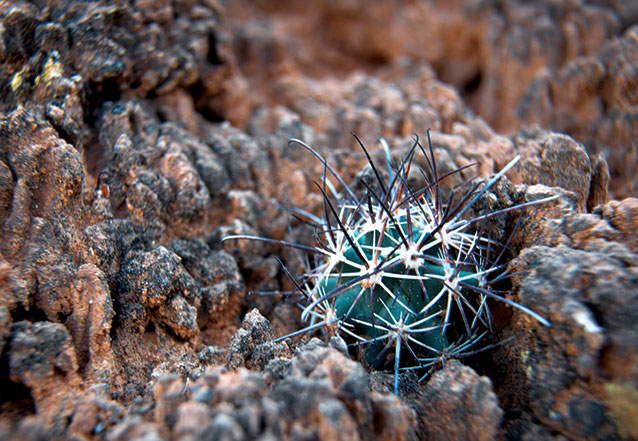
NPS/Neal Herbert
Key words: biodiversity, climate change, ecosystem services, soil carbon sequestration, soils
THE 68TH UNITED NATIONS GENERAL ASSEMBLY declared 2015 the International Year of Soils (FAO 2015). The goal of this designation was to increase awareness about the fundamental relevance of soils for human societies. The declaration also called for the initiation or renewal of policies and actions aimed at sustaining soils globally. Because they are slow to recover from disturbance, soils are considered a nonrenewable resource (fig. 1) and must be preserved in order to secure a sustainable future for humanity. The value of conserving soils lies with the fact that soils are the basis for (1) producing healthy food; (2) cultivating vegetation for animal feed, fiber, fuel, and medicinal products; (3) supporting Earth’s biodiversity; (4) combating and adapting to climate change; and (5) storing and filtering water. As the International Year of Soils comes to a close and the National Park Service begins its centennial year, we hope to stimulate appreciation for the diverse and important—though often overlooked—roles that soils play as integral, ubiquitous park resources through this brief series of “In Focus” articles.
Soil and parks
Most people know soil¹ for its agronomic qualities—that our food grows in it. But soils are intrinsic to how we experience and interact with our national parks. Soils are underfoot when we hike a trail, pitch a tent, or stop at a scenic overlook. They support vegetation, terrestrial food webs, and park roads. Through their diversity and variability, soils help define the very character of the parks and their stories, which brings special meaning to these places.
¹The National Park Service defines soil as “the unconsolidated portion of the earth’s crust modified through physical, chemical, and biotic processes into a medium capable of supporting plant growth” (NPS 2014).
Soils provide unique assemblages of nutrients via mineral and rock weathering that supports ecological niches. For example, at Golden Gate National Recreation Area and Point Reyes National Seashore in California, soils formed on old hydrothermally altered seafloor deposits that have a relatively low calcium and high magnesium content. Only plants that can adapt to these growth-limiting conditions are able to survive in these soils. Some of the rare and endangered plants thriving on these soils derived from serpentinite are Presidio clarkia (Clarkia franciscana), San Francisco wallflower (Erysimum franciscanum), Raven’s manzanita (Arctostaphylos hookerii ssp. ravenii), and Franciscan thistle (Cirsium andrewsii).
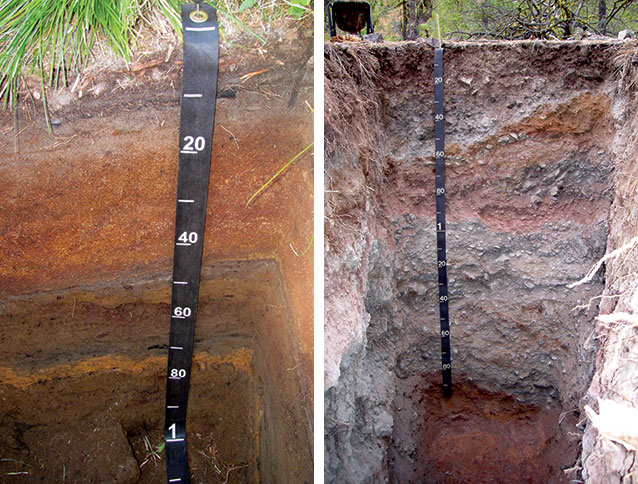
USDA/Susan Southard (2)
Trees of the Pacific Northwest in Mount Rainier, North Cascades, and Lassen Volcanic National Parks thrive on the unique chemistry and physical properties of soils formed from volcanic ash (figs. 2 and 3). Ash parent material often weathers to form noncrystalline particles of aluminum and silica that have high capacity for storing and exchanging calcium, magnesium, and other cations that are important nutrients for plant growth. In contrast, plant communities in the southwestern desert parks are adapted to living in harsh conditions with soils that have a high carbonate content and high salinity.
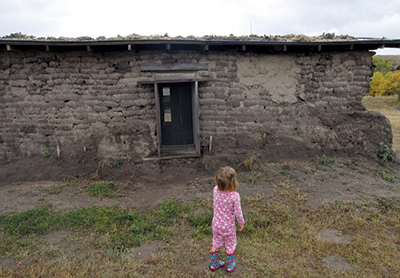
Used by permission, courtesy of Jeff Taylor
Human history and culture are also entwined with soils. In Dinosaur (Utah and Colorado) and Bandelier (New Mexico) National Monuments, for example, they provided paint and dyes for pottery and petroglyphs. They were used as building materials for sod houses at Homestead National Monument of America (Nebraska; fig. 4), prehistoric homes at Wupatki and Walnut Canyon National Monuments (Arizona), and pit house daub at Shiloh National Military Park (Tennessee and Mississippi). Soils are the adobe at John Muir (California) and Bent’s Old Fort (Colorado) National Historic Sites, and Tumacacori National Historical Park (Arizona; fig. 5). They constitute the earthworks at Gettysburg National Military Park (Pennsylvania), Morristown (New Jersey), Valley Forge (Pennsylvania), and Hopewell Culture (Ohio) National Historical Parks; Effigy Mounds National Monument (Iowa); and other parks (figs. 6 and 7).
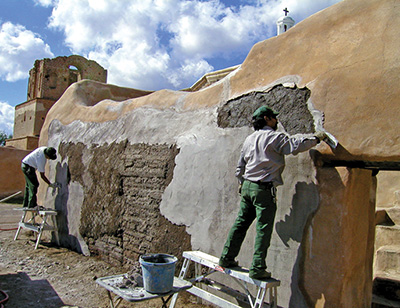
NPS/David Yubeta
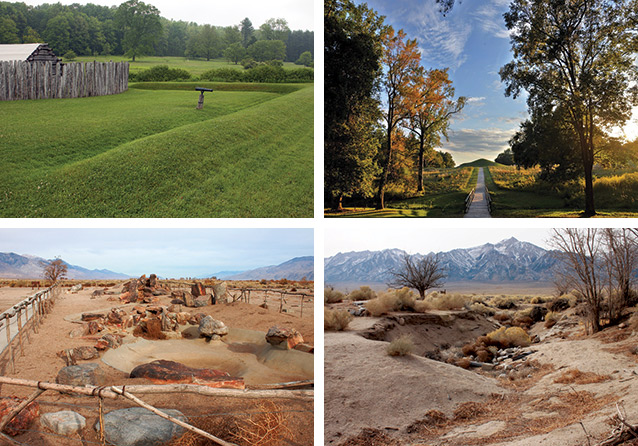
Top left: USDA/Susan Southard; Top right: NPS photo; Bottom left: USDA/Susan Southard; Bottom right: USDA/Susan Southard
Soils figured in human stories memorialized at some parks. For example, Japanese-Americans who were interned at Manzanar National Historic Site (California) suffered from the high wind erodibility of the soils blowing off the granitic fans of the eastern Sierra Nevada and the relentless fugitive dust of Owen’s Lake to the south (fig. 8). Today Manzanar is subject to water releases from diversion dams onto low-cohesion soils formed in granite that result in erosion of cultural resources (fig. 9). The failure of the South Fork dam in 1889, which is remembered at Johnstown Flood National Memorial (Pennsylvania), may have been due in part to high silt content of the soils formed in shale that was used to construct the earthen dam.
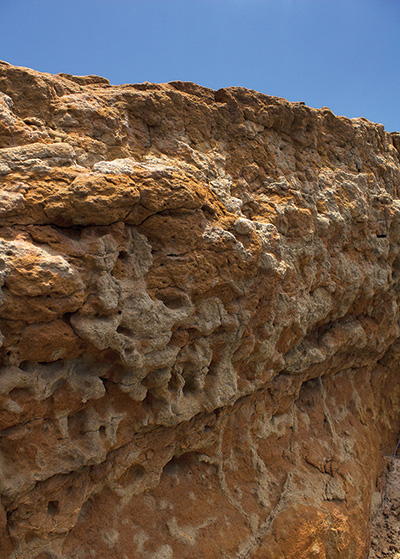
USDA/Susan Southard
Because they preserve events of the past, soils provide strong clues to the geologic processes that formed the landscape. For example, the layering of tephra (soils formed from volcanic ash) and glacial deposition in North Cascades (Washington), Mount Rainier (Washington), Denali (Alaska), and Lassen Volcanic (California) National Parks can both be observed in soil profiles. Continental-scale glacier margins from the last ice age are reflected in the soils of Voyageurs National Park (Minnesota), Delaware Water Gap National Recreation Area (Pennsylvania and New Jersey), and Pictured Rocks National Lakeshore (Michigan). Paleosols (fossil soils) preserve a history of paleoclimates in tectonically uplifted marine deposits on the California coast, including sites at Cabrillo National Monument and Golden Gate National Recreation Area (fig. 10). The Big River soil mapped in Redwood National Park may preserve a record of past tsunamis.
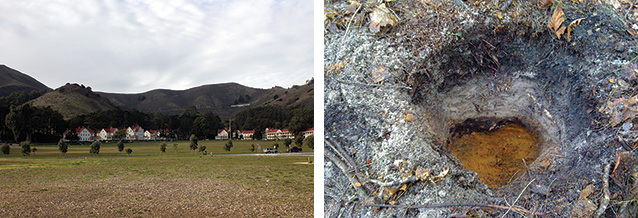
Left: USDA/Susan Southard; right: USDA/Charles Delp
Anthropogenic soils such as fill areas in Golden Gate NRA (California) and Gateway NRA (New York and New Jersey) serve as examples where human-modified soils have been identified and classified and are included in the NPS Soil Resource Inventory (fig. 11). These soils preserve important histories of why and how humans have altered their natural environment.
How do park environments play such fundamental roles in defining the character of our soils? It is diversity and combinations of physical, chemical, and biological characteristics and how these factors interact that distinguish soils (fig. 12). A five-part model helps scientists classify soils by discerning their properties based on the interaction of water and (1) parent material (rocky type), (2) organisms (including people), (3) time (often measured geologically), (4) climate, and (5) topography. Soil surveys have been conducted over the past 20 years through the NPS Natural Resource Stewardship and Science Inventory and Monitoring Program in partnership with the National Cooperative Soil Survey Program led by the USDA Natural Resources Conservation Service. This effort has provided basic information on soil types and their distribution in more than 270 national parks. The soils data and information are constantly being refined and updated, providing parks with important data sets that relate to the management of park natural and cultural resources, facilities, and operations.
Three emerging issues
Just as it prescribes management guidelines for species and other park resources and values, NPS Management Policies 2006 (NPS 2006, section 4.8.2.4) directs the National Park Service to conserve soils. An important component of this policy is the use of science to inform our understanding of soil formation processes, soil properties and behavior, and what activities are detrimental to soils. This information helps us determine best management practices.
Three contemporary management issues relate to soils in the following ways:
Carbon sequestration
Decomposing plants and animals contribute organic matter to soils, including organic carbon, nitrogen, and other plant nutrients. This soil organic matter is about half organic carbon and increases pore space and other soil properties, such as water-holding capacity, that are essential for plant growth. Microbial degradation of soil organic matter can either make nutrients available to plants or transform them to make uptake by plants difficult; in either case these processes create reserves of organic carbon in soil, resulting in soil carbon sequestration.
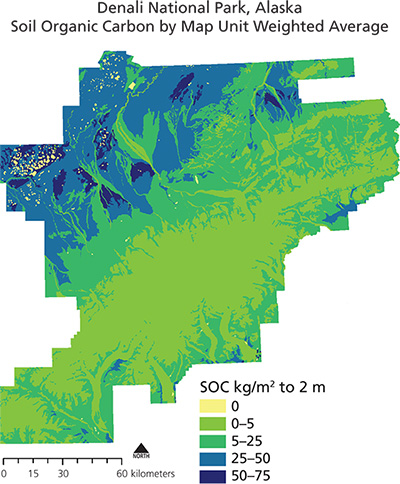
NRCS/Susan Southard, based on SSURGO data
Soil is the largest terrestrial carbon sink on Earth, and parks contribute to the carbon sequestration process through their protected status. Carbon bound in soil buffers ecosystems against the effects of global climate change and is sustained in part through good park management. The aforementioned soil surveys provide a way to account for soil carbon and have been used to highlight park soil carbon stocks (fig. 13). The role of soils in carbon sequestration on park lands will become increasingly important as we seek to understand and adapt to the impacts of climate change on park resources and processes.
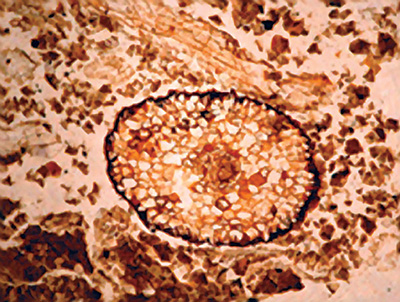
NPS/Art Cohen
Biodiversity
Soils host one-fourth of the world’s biodiversity in bacteria, fungi, and invertebrates (fig. 14). They provide a critical habitat for plants (roots) and burrowing animals such as snakes, armadillos, prairie dogs, ground squirrels, gophers, moles, and burrowing owls. They also contain a broad range of climatic and chemical environments. Though taxonomists have only scratched the surface of inventorying the myriad species found in soils, biodiversity will surely increase significantly as these lesser-known soil microhabitats are explored. Similarly, although bioblitzes conducted broadly in national parks have added to our knowledge and understanding of life in these places, there have been few attempts to paint a picture of life belowground. Nevertheless, scientists can provide impressive estimates for soil organisms. These estimates range from 9,000 species of bacteria and Archaea per cubic centimeter (549/cu in), 100 genera of nematodes per square meter (131/cu yd), and more than 100 species of mites per square meter (131/cu yd) (Bardgett and van der Putten 2014). Altogether these species provide for a number of beneficial processes and services.
Ecosystem services
Soils play many important roles in ecosystems. By providing physical media and supplying water and nutrients for plants and animals, soils support the very basis of all food webs and park species. Soils store, filter, and purify water; regulate water flow; control erosion; mitigate flooding; and cycle plant nutrients such as nitrogen, all of which are important services that help sustain landscapes across the National Park System. Outside of parks, soils are involved in the production of hundreds of everyday products that benefit humans, including clay, sand, and gravel in the construction of road beds, and raw materials used to manufacture insulation and filters. Microbes gathered from soils are used in the production of antibiotics (Ness 2015), and earthworms are important as fish bait. Soils even exert controls over pests and diseases through properties such as ionic strength and pH, and soluble organic carbon content (Comerford et al. 2013).
Soil science
Soils are ubiquitous in national parks and in our lives, and our efforts to understand how they behave and interact with their environments are critical. So to round out our primer the following two articles highlight important advances in resource science and management related to soils. In addition to their specific areas of focus, these investigations improve our understanding of how, through dynamic and static processes, soils are linked to numerous other resources and activities in parks and in the broader landscapes beyond parks. The National Park System includes an amazing array of soil types, functions, and services. By continuing to develop our understanding of them we can celebrate their importance in parks alongside memorials, rivers, and wildlife.
References
Bardgett, R. D., and W. H. van der Putten. 2014. Belowground biodiversity and ecosystem functioning. Nature 515:505–511.
Comerford, N., A. Franzleubbers, M. E. Stromberger, L. Morris, D. Markewitz, and R. Moore. 2013. Assessment and evaluation of soil ecosystem services. Soil Horizons 54. doi:10.2136/sh12-10-0028.
FAO (Food and Agriculture Organization of the United Nations). 2015. 2015 International Year of Soils: Healthy soils for a healthy life. Food and Agriculture Organization of the United Nations, Rome, Italy. Accessed 8 October 2015 from http://www.fao.org/soils-2015/en/.
Ness, E. 2015. The hunt for antibiotics in soil. CSA News 60(7):4–9. Accessed 14 September 2015 from https://dl.sciencesocieties.org/publications/csa/articles/60/7/4.
NPS (National Park Service). 2006. Management Policies 2006. U.S. Department of the Interior, National Park Service, Washington, D.C., USA. Available at https://www.nps.gov/policy/mp2006.pdf.
———. 2014. Soil resource management in the national parks. National Park Service, Washington, D.C., USA. Accessed 16 November 2015 from https://www.nature.nps.gov/Geology/soils/index.cfm.
About the authors
Susan Southard is a soil scientist with the USDA Natural Resources Conservation Service in Davis, California. Since 2007 she has served as a liaison to the National Park Service for soil mapping conducted as part of the NRCS-NPS Soil Resources Inventory. Gregory Eckert is a restoration ecologist in the Biological Resources Division of the NPS Natural Resource Science and Stewardship Directorate in Fort Collins, Colorado. He applies his training in soil ecology to the assessment and restoration of degraded natural resources.
Download: PDF of this article
This article published
Online: 6 May 2016; In print: 25 March 2016
URL
https://www.nps.gov/ParkScience/articles/parkscience32_2_54-59_southard_eckert_3836.htm
Suggested citation
Southard, S., and G. Eckert. 2016. Celebrating soils across the National Park System. Park Science 32(2):54–59.
This page updated
5 May 2016
Site navigation
• Back to Volume 32, Number 2
• Back to Park Science home page
Tags
- bandelier national monument
- bent's old fort national historic site
- cabrillo national monument
- congaree national park
- delaware water gap national recreation area
- denali national park & preserve
- dinosaur national monument
- effigy mounds national monument
- fort necessity national battlefield
- gauley river national recreation area
- gettysburg national military park
- golden gate national recreation area
- homestead national historical park
- hopewell culture national historical park
- john muir national historic site
- johnstown flood national memorial
- lassen volcanic national park
- manzanar national historic site
- morristown national historical park
- mount rainier national park
- north cascades national park
- ocmulgee mounds national historical park
- pictured rocks national lakeshore
- point reyes national seashore
- redwood national and state parks
- shiloh national military park
- tumacácori national historical park
- valley forge national historical park
- voyageurs national park
- walnut canyon national monument
- wupatki national monument
- park science journal
- ps v32 n2
- in focus soils
- biodiversity
- climate change
- ecosystem services
- soil carbon sequestration
- natural resources
- blog
Last updated: October 16, 2020

